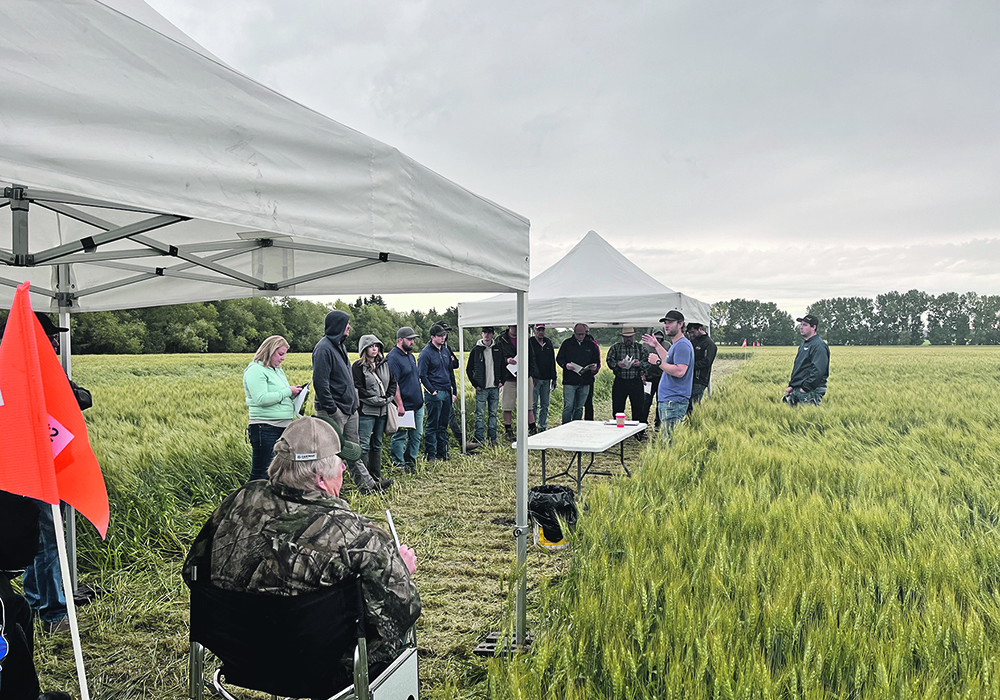Sask Wheat launched the On Farm Trial Program last year, while the Alberta commission has run Plot2Farm since 2018
Still wondering how that plant growth regulator is affecting wheat yields on your farm? How about those nitrogen-fixing foliar products? Are they worth the time and money?
Prairie grain growers have lots of questions about how new products and new agronomic practices affect crop yields, harvestability and net returns. That’s one reason interest in on-farm research programs has been growing.
At its recent annual general meeting in Saskatoon, the Saskatchewan Wheat Development Commission (SaskWheat) reminded growers that on-farm research can be an important complement to research conducted by other organizations.
Read Also

Trump’s tariffs take their toll on U.S. producers
U.S. farmers say Trump’s tariffs have been devastating for growers in that country.
SaskWheat launched its On Farm Trial Program in 2022 and wants growers to take part in the program again this year.
Carmen Prang, agronomy extension specialist with SaskWheat, said the program assists on-farm research trials and allows farmers to test practices and products on their farms, under their conditions, using their own machinery.
Completed projects contribute to a wider understanding of how certain products and agronomic practices can benefit growers. And, the program produces localized data that is specific to growers in different regions of the province.
Last year, in its first year of operation, the program focused on a project that assessed the relationship between seeding rates, plant stand densities and harvested wheat yields.
Four on-farm trial sites were identified at Indian Head, Davidson, Cut Knife and Tisdale. Each trial site consisted of three treatments replicated four times in the field for a total of 12 strips.
The protocol used target plant densities of 20, 25 and 30 plants per sq. foot.
Research findings can be viewed online at saskwheat.ca/on-farm-trial-program.
Prang hopes additional trials can be identified and new research sites added.
“We’re always looking for research ideas so if producers have an idea that they want to try, definitely let us know,” Prang said.
“We’re also hoping that (this year) we can get some agronomists involved and have them collect some of the data on behalf of the farmers.”
SaskWheat’s on-farm research program is similar to on-farm programs that have been established in Manitoba and Alberta.
In Alberta, the Plot2Farm program managed by the Alberta Wheat Commission (AWC) has been growing each year since it was launched in 2018.
In 2022, 12 projects were conducted, looking at issues such as optimal seeding rates, variety comparisons, the benefits of plant growth regulators on yield and harvestability, and in-crop nitrogen fixing foliar products.
Research results are posted online at www.albertawheatbarley.com/plot2farm.
“The goal of the program is to provide farmers with the structure and support to implement on-farm research trials with their genetics and their management in their location and their environment,” said AWC agronomy research extension manager and Plot2Farm program co-ordinator Jeremy Boychyn.
“Basically, we’re looking to get an idea of how some of these management practices may impact farm (management and profitability) but also the yield and quality of that crop.
“We’ll work with growers, one-on-one, to determine trial location, trial size and the logistics of how the trials are going to be implemented and how data will be collected.”
“As always, we’re looking for a wide range of producers to participate, from all across Alberta, anywhere from the Peace down to Milk River.”
Boychyn said projects conducted over the past few years have produced valuable findings that will help to guide management decisions across the province.
In 2022, a project conducted near Willingdon, Alta., looked at the use of plant growth regulators as a method of reducing lodging in CWRS wheat variety AAC Wheatland VB.
The project suggested that the use of Manipulator 620 had only a minor impact on grain yield but had a significant positive impact on percentages of minor and major lodging within replicated plots.
Equipment operation also showed increased harvestability challenges in untreated checks, suggesting “there could be an economic savings of time and fuel” in Wheatland VB crops treated with Manipulator, under certain conditions.
“Under those conditions that we saw last year in the north part of the province, there is potential for value (in using PGRs) for producers growing that variety in that part of the world,” Boychyn said.
Research projects looking at the use of 15-inch row spacings versus 7.5-inch row spacings in cereal crops also produced research insights about the relationship between row spacings and residue management, weed management and grain yield.
Boychyn and Prang said growers who are prepared to commit the needed resources, including land, labour and equipment, can yield valuable information that can be applied quickly on a wider all-farm scale.
“In general, the practices that we are implementing through these trials are practices that farmers could implement on their farms the following year,” Boychyn said.
Saskatchewan growers interested in participating in SaskWheat’s On Farm Trial Program should contact SaskWheat by email at info@saskwheat.ca or by phone at 306-653-7932.
Alberta growers interested in the Plot2Farm program should apply to participate as soon as possible. Application forms are available online at www.albertawheatbarley.com/plot2farm.
















